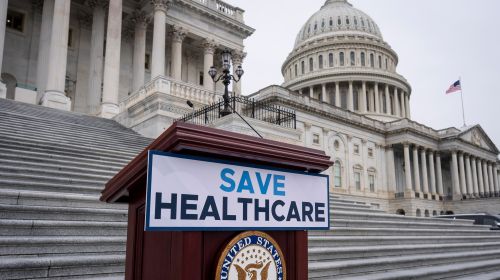

The shutdown has exposed the extent to which cruelty and spectacle have replaced responsibility as the engines of political life.

By Matthew A. McIntosh
Public Historian
Brewminate
Introduction
The United States government has ground to a halt once again, this time over the future of the Affordable Care Act’s premium subsidies, and the consequences are spreading fast. What began as a standoff over funding has morphed into a nationwide health crisis, with millions of Americans bracing for higher insurance premiums and lapses in coverage. At the center of the deadlock stands President Donald Trump, whose demand that Congress refuse to extend ACA subsidies has forced a shutdown that touches nearly every household.
Negotiations have stalled as Democrats insist that continuing federal support for the ACA is essential to keeping premiums stable, while Republicans have framed their opposition as a matter of “border fairness.” Trump and his allies claim the subsidies allow “illegal aliens” to benefit from taxpayer-funded health care, a claim repeatedly contradicted by the law itself and by nonpartisan policy experts. Undocumented immigrants are already barred from purchasing ACA coverage or receiving federal tax credits. Yet the political fiction has proved powerful, transforming a technical fiscal debate into another cultural flashpoint.
Meanwhile, the economic fallout deepens. insurance providers are warning of immediate market instability as reinsurance funds dry up, forcing potential premium increases of up to 26 percent in some states. The shutdown also freezes key functions of the Department of Health and Human Services, delaying reimbursements and leaving healthcare workers uncertain about federal pay. And compounding the crisis, Trump’s own trade tariffs on pharmaceuticals have already inflated prescription drug costs, ensuring that Americans now face rising expenses from both policy fronts at once.
This shutdown is not merely bureaucratic gridlock; it’s the intersection of ideology and consequence. The rhetoric of “America First” has once again produced an America footing the bill, as partisan theater over imaginary beneficiaries threatens to make healthcare less affordable for the very citizens it claims to protect.
The Policy Core: What Is Actually at Stake
At the center of the shutdown is a deceptively simple question: should the federal government continue funding the Affordable Care Act’s enhanced premium tax credits that make marketplace insurance affordable for millions of Americans? These credits, expanded under pandemic-era legislation and renewed twice with bipartisan support, are now set to expire without congressional action. Roughly 21 million Americans currently rely on those subsidies to keep premiums within reach, a number that includes large majorities of enrollees in several red states. Without an extension, many families could see monthly costs double overnight.
The issue is not new, but the political calculus has shifted. Democrats argue that maintaining the credits prevents massive premium spikes and stabilizes insurance markets. Republicans, led by Trump, have reframed the debate as a fight over fiscal integrity and immigration. The president insists that the subsidies are “riddled with waste” and “abused by illegals,” despite evidence to the contrary from the nonpartisan Congressional Budget Office. This framing has allowed what was once a technical policy renewal to become a symbolic litmus test of partisan loyalty and a flashpoint in the broader culture war over national identity.
Florida as the Bellwether
Nowhere is this political theater more visible than in Florida, where Democrats have launched a full-scale campaign to highlight how the shutdown threatens Trump’s own constituents. Senate Democrats held a press event in Miami this week, pointing out that Florida has the largest ACA enrollment in the country, over 4.7 million people. If subsidies lapse, Floridians would face some of the steepest premium increases nationwide.
The irony is stark: many of the same voters who helped return Trump to office now stand to lose the most from his shutdown strategy. Health policy analysts note that Florida’s insurance market is unusually sensitive to federal subsidy levels, meaning even short disruptions can destabilize pricing. Yet the political messaging remains unchanged, Trump continues to claim he is protecting Americans from a “broken and corrupt system,” while refusing to acknowledge that the system he is freezing is the one keeping millions insured.
The stage is set for a broader reckoning: a president who rose to power by promising to defend “forgotten Americans” now presides over a policy impasse that could make their lives materially harder, costlier, and less secure. The numbers from Florida are a microcosm of what the rest of the country could soon face, a test of how far partisan loyalty can stretch before economic reality breaks through.
The Myth at the Center: Immigrants and ACA Eligibility
The entire shutdown hinges on a claim that doesn’t survive even a moment’s scrutiny. Trump and Republican leaders argue that continuing federal subsidies under the Affordable Care Act would allow “illegal aliens” to receive taxpayer-funded healthcare. Yet, undocumented immigrants are completely barred from purchasing insurance through ACA marketplaces, from receiving premium tax credits, and from enrolling in Medicaid or CHIP, except in the most limited emergency circumstances. That has been the law since the ACA was passed in 2010, under both Democratic and Republican administrations.
The confusion is not accidental. By conflating ACA eligibility with emergency medical access, the administration has turned a straightforward policy renewal into a cultural flashpoint. The law known as EMTALA, the Emergency Medical Treatment and Labor Act, requires hospitals to stabilize anyone who arrives at an emergency room, regardless of insurance or citizenship. That safeguard predates the ACA by decades, actually signed under President Ronald Reagan, and exists to prevent hospitals from refusing treatment in life-or-death situations. It has nothing to do with ACA subsidies or coverage.
Still, Trump’s rhetoric has proven politically potent because it taps into an emotional reflex, the idea that “someone else” is benefitting unfairly. This narrative distracts from the reality that the people hurt most by the shutdown are American citizens: middle- and working-class families who depend on subsidies to afford coverage. The administration’s position functions less as a fiscal argument than a symbolic one, a manufactured grievance that disguises the harm being done to its own supporters.
“They Can Still Use the ER”: Why That Talking Point Is False Comfort
Republican lawmakers defending the shutdown often fall back on a single refrain, that even if people lose coverage, “they can still go to the emergency room.” It’s a line designed to sound compassionate without conceding policy failure. It’s also ironic given their desire to eliminate Reagan’s law requiring emergency treatment for all persons regardless of insurance or citizenship status. The Emergency Medical Treatment and Labor Act (EMTALA) only guarantees emergency stabilization, not comprehensive care. Hospitals are required to treat a heart attack, not manage diabetes. They can stop the bleeding, not provide chemotherapy. Once a patient is stabilized, responsibility, and the bill, returns to them.
Those visits are also the most expensive form of care in the American system. When uninsured patients receive emergency treatment, hospitals absorb the costs and pass them along in higher fees and premiums for everyone else. The American College of Emergency Physicians estimates that uncompensated emergency care adds billions annually to system-wide expenses, raising costs for insured and uninsured patients alike.
This “ER fallback” argument, then, is no safety net at all. It’s a cost-shifting mechanism that worsens the very problem Republicans claim to oppose: inflated healthcare spending. The Affordable Care Act was designed in part to reduce that burden by expanding preventive and routine coverage. Dismantling it while touting emergency rooms as an alternative is like burning the fire department and handing everyone a bucket, it offers the illusion of readiness while guaranteeing catastrophe.
In the end, the promise that “care will still be available” rings hollow. The question has never been if care exists, but who can afford it. And in the America this shutdown is shaping, that answer grows narrower every day.
Costs Already Rising from Trump’s Pharmaceutical Tariffs
While the shutdown dominates headlines, another policy decision from the Trump administration is already compounding the financial strain on patients. Earlier this year, the president imposed sweeping tariffs on imported pharmaceuticals, including active ingredients used in everyday medications. The measure was framed as part of his “America First” manufacturing strategy, a way to punish foreign suppliers and revive domestic production. But the practical outcome has been the opposite: higher prices and disrupted supply chains for U.S. consumers.
Nearly 80 percent of the active ingredients in U.S. pharmaceuticals come from abroad, primarily China and India. When those imports were hit with new tariffs, manufacturers passed the added costs directly to wholesalers and insurers, who then passed them to patients through elevated drug prices and premiums. The administration’s claim that “short-term pain” would yield long-term savings has not materialized. Instead, hospitals are warning of shortages, and pharmacies report rising costs for essential medications ranging from antibiotics to insulin.
For Americans already facing the possibility of losing ACA subsidies, the timing could not be worse. A Guardian report described the tariff as “a blunt instrument” that punishes patients rather than producers. Pharmaceutical companies with U.S. operations have been reluctant to expand manufacturing under such unpredictable policy swings, meaning the promised domestic boom remains speculative at best.
What emerges is a perfect storm of economic self-sabotage: a healthcare system under stress from withheld subsidies, a pharmaceutical market inflated by tariffs, and a political class pretending these crises are unrelated. The same administration claiming to fight for lower costs has engineered conditions where every visit, every refill, and every policy renewal costs more.
The Political Choreography
At its core, the shutdown is less a legislative impasse than a stage performance, an orchestrated political drama designed for maximum partisan contrast. Negotiations have repeatedly broken down not because of substantive disagreements over budget mechanics, but because both sides are entrenched in the optics of victory. Democrats insist that extending ACA subsidies is a moral and economic necessity, while Trump and congressional Republicans are framing the issue as a referendum on “fiscal discipline” and border control.
The president’s message machine has been relentless: the shutdown, he argues, is about “stopping waste and fraud,” a vague accusation that remains unsupported by any data. When pressed, Republican leaders pivot to claims about undocumented immigrants or “unverified enrollees,” despite no evidence of systemic abuse. The nonpartisan Congressional Budget Office, in its most recent review, found that ACA subsidies reduce federal deficit spending by lowering uncompensated care costs, meaning they save money in the long term. But in the Trump-era GOP, empirical data rarely competes with emotional narrative.
Democrats, for their part, have leaned into symbolism as well, staging press events in states like Florida and Arizona to showcase constituents whose premiums are set to spike. Politico noted that a small bipartisan group has floated a temporary reauthorization plan that would keep the government open while allowing time for targeted oversight measures, a compromise quietly supported by several moderate Republicans. But Trump’s influence remains decisive: he has publicly threatened to campaign against any GOP member who votes for “Democrat subsidies.”
The result is paralysis by political theater. Each side accuses the other of cynicism, yet both are calculating how the crisis will play in 2026. Democrats see the shutdown as an opportunity to spotlight Trump’s disregard for working-class Americans, while Trump’s team views it as another loyalty test for his party, a chance to consolidate power through defiance. In that contest, ordinary citizens are collateral damage, trapped between spectacle and survival.
The Human Stakes
Beyond the noise of cable headlines and partisan spin, the shutdown’s impact is being measured in doctor visits missed, prescriptions delayed, and family budgets pushed to the breaking point. Millions of Americans are already receiving notices from insurers warning that premiums could rise by hundreds of dollars a month if federal subsidy payments aren’t restored soon. The Associated Press has reported growing anxiety among families facing the renewal period, particularly in states with high enrollment through the federal marketplace.
For many, this isn’t a theoretical concern, it’s a choice between health coverage and groceries. One nurse in Texas told reporters she and her husband, both self-employed, would see their premium jump from $340 to nearly $800 per month without federal assistance. Across the Midwest, clinics that depend on federal reimbursements for low-income patients are cutting hours, while hospitals warn that if the shutdown drags on, community health programs could run out of funding altogether.
The strain is particularly severe in rural areas, where ACA subsidies have been a lifeline keeping small hospitals open. The AP noted that facilities in several southern states are already operating on razor-thin margins, and even short interruptions in federal payments can push them toward insolvency. These are the same regions Trump has long claimed to champion, and yet, it is precisely their residents who are now shouldering the consequences of his shutdown strategy.
The human toll extends beyond economics. Health insurance is often a proxy for stability and dignity, a measure of whether the system recognizes someone’s worth. To strip that away over a political talking point about nonexistent benefits for undocumented immigrants is more than negligence; it’s cruelty disguised as governance. Every day the government remains closed, the abstract language of policy becomes tangible suffering for ordinary people.
“America First” That Hurts Americans First
For years, Trump has framed his economic and foreign policies under the banner of America First, a slogan meant to evoke self-reliance and national strength. But in practice, that vision has repeatedly translated into Americans paying the price for policies that claim to protect them. The shutdown over ACA subsidies is simply the latest and most visible example of this inversion, a movement that declares itself patriotic while dismantling the very systems that safeguard ordinary citizens.
The Affordable Care Act’s subsidies have been one of the most effective cost-containment measures in the modern healthcare system, reducing uninsured rates and stabilizing private insurance markets. Ending them in the name of “fiscal discipline” while preserving tax cuts for the wealthy exposes the hollowness of the administration’s priorities. Meanwhile, Trump’s pharmaceutical tariffs, marketed as a blow against foreign dependency, have inflated the cost of essential medications and medical supplies at home. In each case, the rhetoric of national defense becomes a mechanism for domestic extraction: American consumers subsidizing the government’s political theater.
This is not new in Trump’s playbook. His trade wars, his attacks on renewable energy, and his defunding of public health initiatives all share a pattern, policies justified through populist slogans that ultimately benefit corporations, not citizens. By invoking nationalism, he masks redistribution from the bottom up. The ACA shutdown takes that same formula and applies it to healthcare: stoke resentment toward imaginary outsiders, then use that resentment to justify stripping aid from one’s own base.
“America First” becomes, in effect, “America pays first.” Citizens foot the bill in higher premiums, costlier prescriptions, and lost services, all to sustain a narrative that places blame everywhere but where it belongs. What began as a promise to defend working families has devolved into a system that punishes them for existing. And in the absence of accountability, the cruelty isn’t incidental; it’s the point.
Off-Ramps and Accountability
There are, in fact, clear solutions to end the shutdown, but none that fit neatly within Trump’s zero-sum political calculus. Lawmakers from both parties have proposed temporary extensions of the ACA’s enhanced subsidies while conducting an audit of the program’s costs and eligibility. As Politico reported, a bipartisan group in the House introduced a framework that would reopen the government immediately, continue ACA funding for one year, and require quarterly transparency reports from insurers. The plan would stabilize markets without making any permanent policy changes, a practical off-ramp in a moment dominated by ideology.
Yet Trump has rejected compromise out of hand, calling any temporary renewal “a betrayal of the American taxpayer.” Republican moderates privately admit that the political cost of defying him remains too high. With the 2026 midterms looming, many fear primary challenges from the far-right if they are seen as conceding to Democrats. This loyalty trap has rendered Congress largely inert, a body capable of outlining pragmatic solutions but paralyzed by the gravitational pull of Trump’s influence.
For Democrats, the path forward is equally delicate. They have little incentive to accept partial funding bills that exclude the subsidies, knowing that doing so would normalize the use of shutdowns as hostage-taking. Instead, they’re leveraging public frustration to underscore a broader message: that Trump’s politics of resentment come at the expense of the nation’s well-being. The longer the impasse continues, the clearer the contrast becomes between governance as service and governance as spectacle.
Ultimately, ending the shutdown will require more than a procedural vote. It will require a reckoning with the idea that cruelty has become a governing principle, that policies are being crafted not to solve problems, but to inflame them for political gain. Until that reckoning comes, every temporary fix will merely postpone the next manufactured crisis.
The off-ramp exists; the question is whether the political will does.
Conclusion: The Cost of Manufactured Crisis
What began as a fight over health policy has become a moral x-ray of American governance. The shutdown has exposed the extent to which cruelty and spectacle have replaced responsibility as the engines of political life. Behind every speech about “fraud” or “illegals” lies the same truth, that millions of citizens are being asked to bear the pain of policies built on fiction.
The Affordable Care Act was never perfect, but it remains one of the few mechanisms that tether everyday Americans to affordable healthcare. Its subsidies are not charity; they are the scaffolding that keeps the system upright. To dismantle them out of spite or opportunism is to punish stability itself. The economic cost of this standoff already outweighs the funding in dispute, a textbook case of ideology defeating arithmetic.
Trump’s “America First” mantra promised empowerment but has instead delivered inflation, isolation, and rising inequality. His tariffs raised drug costs; his shutdowns destabilize families; his rhetoric divides the very people he claims to defend. The result is not leadership, but governance by grievance, a politics that feeds on resentment while calling it strength.
The longer the government remains closed, the clearer the stakes become. This is not simply a budgetary dispute, nor even a partisan struggle. It is a test of whether facts, empathy, and accountability still have any place in American public life. If they don’t, the cost of this shutdown will extend far beyond premiums and policies, it will be measured in the steady erosion of the common good.
Originally published by Brewminate, 11.05.2025, under the terms of a Creative Commons Attribution-NonCommercial-NoDerivatives 4.0 International license.


